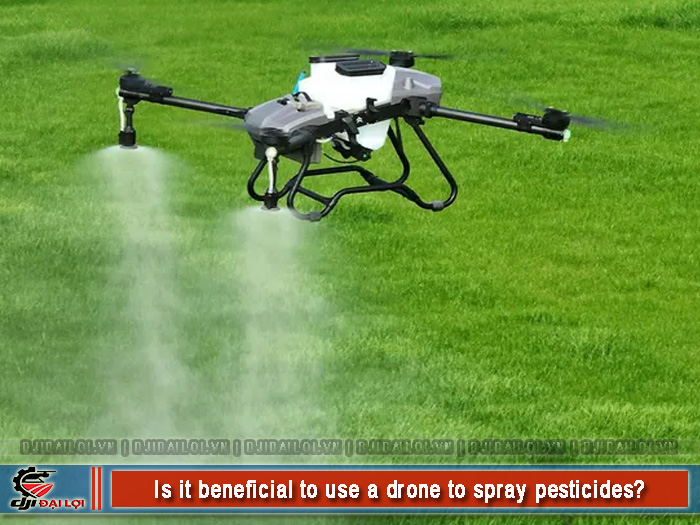
Why farmers are switching to drones
Labor shortages and rising wage costs are driving farmers toward UAV spraying systems. Field trials in Đồng Tháp and An Giang show drones can spray 5–8 times faster than manual labor. Automatic GPS control ensures precise spraying, reducing pesticide waste by up to 20%.
Role of UAVs in precision agriculture
Spraying drones are not just flying machines - they are agricultural data centers. With integrated radar, GPS, and height sensors, drones deliver even spray distribution, minimize environmental impact, and optimize chemical use. This technology forms the foundation of precision agriculture, where data-driven decisions enhance efficiency and resource management.
Impact of automation on productivity and cost
Replacing manual spraying with drones reduces labor costs by 60–70% per crop cycle and increases labor productivity by 300–500%, particularly valuable for large-scale farms that require fast, precise operations.
Improved spray efficiency and even coverage
Models like DJI Agras T30 and T40 feature dual high-pressure nozzles and radar guidance that produce ultra-fine mist, increasing spray coverage by 25–30% compared with manual spraying.
Labor savings and long-term cost reduction
A single drone can replace 5–7 workers. Despite high upfront costs, farmers can typically recover investment within 2–3 harvest seasons thanks to savings on labor, fuel, and pesticide usage.
Reduced chemical exposure and better worker safety
Drone spraying eliminates direct contact with toxic substances, significantly lowering risks of respiratory and skin diseases. This safety benefit has made UAVs especially popular among agricultural cooperatives transitioning to high-tech farming.
High-precision spraying with radar and smart sensors
Dual millimeter-wave radar and obstacle sensors allow drones to follow pre-mapped routes, automatically adjusting altitude for tall trees or uneven terrain, ensuring consistent and waste-free coverage.
Versatile operation on various terrains
UAV sprayers operate effectively in flooded rice fields, hilly orchards, and forest plantations. With speeds up to 6 hectares per hour, they are ideal for large-scale cultivation models.
High upfront investment and imported components
Spraying drones cost between 120–250 million VND, excluding batteries and chargers. Most components are imported, making replacement parts and maintenance expensive.
Need for skilled operators and UAV licensing
Operators must be trained in flight planning and UAV safety. Some regions also require flight permits, which can be challenging for farmers unfamiliar with drone operation.
Complex maintenance of batteries, radar, and nozzles
DJI drones require servicing after every 100 flight hours. Lithium batteries need proper charging cycles, and radar systems must be cleaned regularly to prevent sensor errors.
Weather sensitivity: wind and humidity
Strong winds or high humidity can distort spray direction and reduce efficiency. UAV operators should always monitor weather conditions before takeoff.
|
Criteria |
Drone spraying |
Manual labor |
|---|---|---|
|
Spray speed |
4–6 ha/hour |
0.5–1 ha/hour |
|
Coverage consistency |
High and even |
Uneven |
|
Pesticide consumption |
Reduced by 15–25% |
High waste |
|
Labor cost |
Significantly lower |
Increases seasonally |
Accuracy and environmental impact
Field tests in Hậu Giang show UAV spraying is 30% more accurate, while manual spraying often leads to over- or under-application, causing both environmental and financial losses.
Overall economic efficiency
Using drones can save 2–3 million VND per hectare per crop. On a 50-hectare farm, this translates to 100–150 million VND in total savings, equivalent to an entire season’s operating cost.
Regular maintenance and operator training
Cooperatives should organize training programs on safe drone operation, proper battery charging, and radar inspection. Following a consistent maintenance schedule prolongs equipment life.
Integrating UAV spraying with smart farm management
By combining UAV spraying data with digital farm management software, farmers can monitor crop conditions, predict pest outbreaks, and optimize spraying schedules.
Firmware and sensor updates for higher stability
Manufacturers like DJI continuously release firmware updates to improve flight stability and energy efficiency. Users should stay updated to ensure best performance.
AI and GIS integration
Combining artificial intelligence (AI) with geographic information systems (GIS) allows drones to identify pest density zones and spray precisely. This technology is already being tested in smart farming zones in China and Vietnam.
Enhanced autonomy and reduced human input
Next-generation UAVs will be capable of fully autonomous routes, real-time obstacle detection, and auto altitude adjustment, minimizing manual intervention.
Broader crop applications
UAV spraying is expanding beyond rice to fruit trees, coffee, pepper, acacia, and rubber, signaling a strong trend toward diversified agricultural automation by 2030.
When to invest in spraying drones
Farmers should consider UAVs when cultivating over 10 hectares or needing frequent pesticide applications. For smaller fields, renting drone spraying services is more economical.
Choosing the right model for your scale and budget
Key factors: tank capacity, flight duration, and radar system quality.
In conclusion, replacing manual labor with spraying drones is an inevitable step in agricultural mechanization. With proper training and localized technology, UAVs will not only enhance productivity but also improve worker safety and environmental sustainability.
Can spraying drones operate at night?
Yes. Models like DJI Agras T40 and T50 feature radar navigation and LED illumination for safe nighttime spraying.
What is the average lifespan of a spraying drone?
With proper maintenance, agricultural drones can last 4–6 years, equivalent to 1,500–2,000 flight hours before requiring major part replacements.
Can farmers rent drone spraying services instead of buying?
Yes. Many cooperatives and dealers now offer UAV spraying services at 80,000–150,000 VND per hectare, suitable for small-scale farmers.
Do spraying drones harm the environment?
Not significantly. Because drones spray precisely and efficiently, they reduce chemical residue and pollution compared with manual spraying.
Is UAV registration required for agricultural spraying?
Yes. Under Vietnam’s civil aviation regulations, UAV operators must register and fly only in approved zones to ensure safety and compliance with the law.